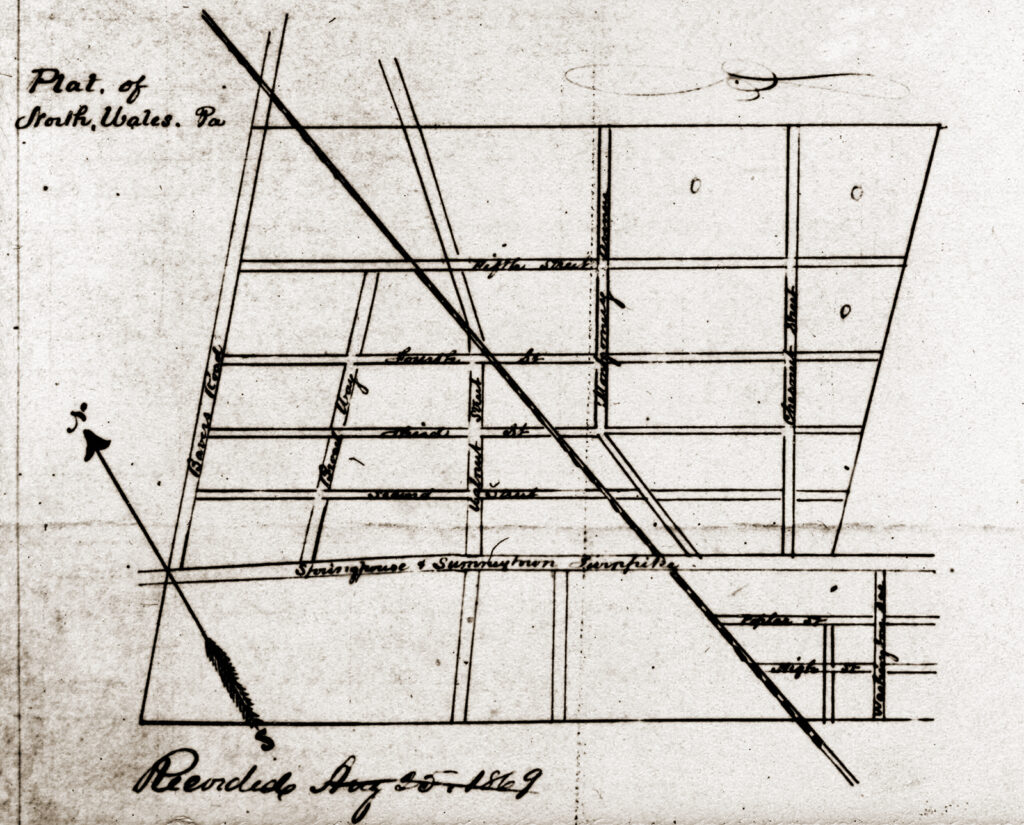Early in the spring of 1868 the possibility and advisability of the village of North Wales detaching itself from Gwynedd township and becoming incorporated into a borough was being discussed among certain citizens.
The matter was talked about, pro and con, all through the summer and into the early fall until finally on November 16, 1868 the following petition was filed in the Court of Quarter Sessions of the Peace for the County of Montgomery, in the court house at Norristown:
“The petition of diverse freeholders and citizens of the village of North Wales in the township of Gwynedd and county aforesaid. Know ye, that they are freeholders and citizens of the village of North Wales aforesaid, situate on and along the Spring House and Sumneytown Turnpike Road at and near where said road crosses the North Pennsylvania Rail Road in said Township of Gwynedd and County of Montgomery aforesaid.
“That said village is a thriving, growing, rapidly increasing, and active business town, containing a depot, lumber yard, coal yard, three general stores, drug store, boot, shoe and trunk store, feed store, flour mill, two hotels, restaurant, a saddlery, harness makers, shoemakers, blacksmith shops, wheelwright shop, steam moulding sash and door manufactory, brick kiln, churches, school house, conveyancer, real estate and insurance offices, a building and loan association, library association and other institutions of learning and usefulness and about 380 inhabitants, sixty-five of whom are freeholders.
“Your petitioners are anxious to have said village incorporated and made a body politic with the name, style and title of the Borough of North Wales, whose boundaries shall be as follows, to wit:
“BEGINNING at a stake set for a corner in a public road in the line of lands of Frederick Beaver and Daniel Kenderdine, thence south sixty degrees and a quarter east respectively by lands of said Kenderdine, David Moyer and John M. Nice and Joseph K. Anders, one hundred and nineteen perches to a corner in land of said Anders, thence by the same south forty-two and a half degrees west eighty-five perches to the Spring House and Sumneytown Turnpike road, thence by the same south sixty degrees east twenty perches to a corner of Samuel R. Birds land, thence by the same south thirty degrees west twenty-eight perches to a corner, thence by land of W. Shearer and George Wolf respectively north sixty degrees west one hundred and fourteen perches to a maple tree on land of George Wolf, thence north forty-one and three quarter degrees east one hundred and thirteen perches to the place of beginning.”

The above description of the boundaries is, of course, an engineer’s description. Perhaps it will be more readily understood if I name the streets that were included within these boundaries. Starting at Main street and going toward the railroad station there was Second, Third and Fourth streets. The intersecting streets from Walnut east were Walnut street and Washington avenue. However, as stated earlier in these articles, there was a lane at what is now Shearer street.
Beginning at Beaver street and going east on Main street there was Broadway (now School street), Walnut street, Montgomery avenue and Chestnut street, now Church street. There were two streets, Poplar and High, running parallel with Main street from the railroad to Washington avenue.
The petition for the incorporation of the borough was approved by the Grand Jury on February 26, 1860. The petition presented to the court for the incorporation was signed by the following citizens: George Cathrall, David Jones, Abel K. Shearer, Ellwood Cleaver, Jacob H. Leister, Isaac G. Freed, Lydia Gerhart, Peter S. Moyer, David Moyer, Henry F. Moyer, Henry W. Moyer, William Miller, Percival Slough, John M. Nice, Jonas D. Moyer, John Alarms, Peter Hover, Hannah Beater, Noah W. Weikel, Isaac N. Wireman, Enos H. Cassel, Elias K. Freed, David Knipe, Mark B. Fretz, James Woodruff, Michael Hasty, Jonathan Lukens, Joseph K. Anders, Frederick Wolf, W. R. Bechtel, J. S. Knight, Henry Bury, William S. Boyd, May Wampole, George Schlotter, Enos H. Kulp, Martha A. Cleaver, Ephraim Neaval, and Evan B. Kepler.
On April 14, 1869, the following remonstrance was filed with the court by certain of the citizens of North Wales, protesting against the incorporation:
“The undersigned inhabitants, residents and freeholders of the village of North Wales respectfully remonstrate against the incorporation of North Wales into a borough as prayed for a November Sessions, 1868, and which was approved by the Grand Jury February 26, 1869, for the following reasons:
1st. That the incorporation of said village into a borough would impose upon the property holders and inhabitants thereof great and unreasonable expense.
2nd. That a large portion of the territory sought to be incorporated is farming territory.
3rd. That your remonstrants further believe that a majority of the freeholders are opposed to said incorporation.
We therefore pray the court to refuse said application, and they will ever pray. David Baker, George W. Nyce, Jacob Wismer, Jacob W. Baker, Enos Kulp, Jacob W. Shearer, Henry Bury, Levi Keller, Daniel Kenderdine, Susannah Howland, Abraham Kriebel, Jr., Enos M. Lukens, James Moyer, Henry Booz, George Young, J. H. Kneedler, William VanFossen and B. Franklin Eaton.”
This post is sourced from a column entitled Early North Wales: Its History and Its People penned by long-time North Wales resident historian Leon T. Lewis. The article appeared in its original form in the July 28, 1959 issue of the North Penn Reporter.
